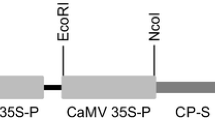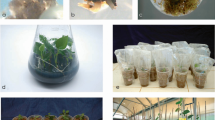Summary
Rhizomania is a disease of sugar beet caused by the furovirus beet necrotic yellow vein virus (BNYVV). Coat protein mediated resistance has been reported for a number of viral diseases. This approach to virus resistance was therefore attempted for control of rhizomania. Two constructs of the coat protein gene of BNYVV were introduced into sugar beet by Agrobacterium-mediated transformation. The mRNA level was estimated to be 0.01% of the poly A+ RNA. Expression of the coat protein gene was under the detection limit of our western blotting protocol i.e. below 0.01 μg/50 μg (0.02% of the total soluble protein). One transformation event per construct was tested in a greenhouse assay and in rhizomania infested soil in a field trial. In the greenhouse assay, transgenic plants showed a strong reduction of virus multiplication when compared to non-transgenic plants. This result was confirmed in the field trial, where a significant difference in virus multiplication was shown between plants with and without the coat protein gene.
Similar content being viewed by others
References
Abe H., & T. Tamada, 1986. Association of beet necrotic yellow vein virus with isolates of Polymyxa betae Keskin. Ann. Phytopathol. Soc. Jpn. 52: 235–247.
Anderson E.J., D.M. Stark, R.S. Nelson, P.A. Powel, T.E. Tumer & R.N. Beachy, 1989. Transgenic plants that express the coat protein genes of tobacco mosaic virus or alfalfa mosaic virus interfere with disease development of some non-related viruses. Phytopathol 79: 1284–1290.
Beachy R.N., S. Loesch-Fries & T.E. Tumer, 1990. Coat protein-mediated resistance against virus infection. Annu. Rev. Phytopathol 28: 451–474 (1990).
Bevan M.W., R.B. Flavell & M.D. Chilton, 1983. A chimaeric antibiotic resistance gene as a selectable marker for plant cell transformation. Nature 304: 184–187.
Brunt A.A. & K.E. Richards, 1989. Biology and molecular biology of furoviruses. Adv. Virus Res. 36: 1–32.
Brunt A.A. & E. Shikata, 1986. Fungus transmitted and similar labile rod-shaped viruses. Pages 305–335 in. The Plant Viruses. Vol. 2, The Rod-Shaped Plant Viruses. M.H.V.Van Regenmortel and Heinz Fraenkel-Conrat, eds Plenum Publishing, New York.
Bouzoubaa S., V. Ziegler, D. Beck, H. Guilley, K. Richards & G. Jonard, 1986. Nucleotide sequence of beet necrotic yellow vein virus RNA-2. J Gen Virol 67: 1689–1700.
Buercy K. & G. Buettner, 1985. Ansaetze zur Selection rhizomaniatoleranter Zuckerrueben waehrend der Jugendentwicklung. I. Virustiter. Zuckerindustrie 110: 997–1000.
De Block M., J. Botterman, M. Vanderwiele, J. Docks, C. Thoen, V. Gosselé, R. Movva, C. Thompson, M.van Montagu & J. Leemans, 1987. Engineering herbicide resistance in plants by expression of a detoxifying gene. EMBO J 6: 2513–2518.
Duffus J.E. & H.Y. Liu, 1987. First report of rhizomania of sugar beet from Texas. Plant Dis. 71: 557.
D'Halluin K., M. Bossut, B. Mazur, J. Leemans & J. Botterman, 1992. Transformation of sugar beet (Beta vulgaris L.) and evaluation of herbicide resistance in transgenic plants. Bio/technology 10: 309–314.
Ecke W., U. Schmitz & G. Michaelis, 1990. The mitochondrial nad5 gene of sugar beet (Beta vulgaris) encoding a subunit of the respiratory NADH dehydrogenase. Curr Genet 18: 133–139.
Ehlers U., U. Commandeur, R. Frank, J. Landsmann, R. Koenig & W. Burgermeister, 1991. Cloning of the coat protein gene from Beet Necrotic Yellow Vein Virus and it's expression in sugar beet hairy roots. Theor Appl Genet 81: 777–782.
Fujisawa I, & T. Suzimoto, 1977. Transmission of beet necrotic yellow vein virus by Polymyxa betae. Ann Phytopathol Soc Japan 43: 583–586.
Gallie D.R., D.E. Sleat, J.W. Watts, P.C. Turner & T.M.A. Wilson, 1987. A comparison of eucaryotic vir 5′-leader sequences as enhancers of mRNA expression in vivo. Nucl Acids Res 15: 8693–8711.
Gielen J.J.L., P.de Haan, A.J. Kool, D. Peters, M.Q.J.M.van Grinsven & R.W. Goldbach, 1991. Engineered resistance to tomato spotted wilt virus, a negativestrand RNA virus. Bio/technology 9: 1363–1367.
Hanley-Bowdon L & C. Hemenway, 1990. Expression of plant viral genes in transgenic plants. In Genetic Engineering with Plant Viruses, Michael T, Wilson A, Davies JW, (eds), pp. 251–275. CRC Press, Boca Raton.
Horsch R.B., J. Fry, N.L. Hoffman, M. Wallroth, D. Eickholtz, S.G. Rogers & R.T. Fraley, 1986. A simple and general method for transferring genes into plants. Science 227: 1229–1231.
Hutchinson P.J., C.M. Henry & R.H.A. Coutts, 1992. A comparison, using dsRNA analysis, between beet soil borne virus and some other tubular viruses isolated from sugar beet. J Gen Virol 73: 1317–1320.
Kallerhoff J., P. Pascual, S. Bouzoubaa, S. Ben Tahar & J. Perret, 1990. Beet necrotic yellow vein virus coat protein-mediated protection in sugar beet (Beta vulgaris L.) protoplasts. Plant Cell Rep 9: 224–228.
Kaniewski W., C. Lawson, B. Sammons, L. Haley, J. Hart, X. Delannay & N. Tumer, 1990. Field resistance of transgenic Russet burbank potato to effects of infection by potato virus X and potato virus Y. Bio/technology 8: 750–754 (1990)
Kaufmann A., R. Koenig & H. Rohloff, 1993. Influence of beet soilborne virus on mechanically inoculated sugar beet. Plant Pathol 42: 413–417.
Kawchuk L.M., R.R. Martin & J. McPherson, 1991. Sense and antisense RNA-mediated resistance to potato leafroll virus in Russet Burbank potato plants. Mol Plant-Microbe Interac 4: 247–253.
Keskin B., 1964. Polymyxa betae n.sp., ein Parasit in den Warzeln von Beta vulgaris Tournefort, besonders während der Jugendentwicklung der Zuckerube. Arch Mikrobiol 49: 348–374.
Laemmli U.K., 1970 Cleavage of structural proteins during the assembly of the head of bacteriophage T4. Nature 227: 680–685.
Lindbo J.A. & W.G. Dougherty, 1992a. Untranslatable transcripts of the tobacco etch virus coat protein gene seguence can interfere with tobacco etch virus replication in transgenic plants and protoplasts. Virology 189: 725–733.
Lindbo J.A., & W.G. Dougherty, 1992b. Pathogen-derived resistance to a potyvirus: Immune and resistant phenotypes in transgenic tobacco expressing altered forms of a potyvirus coat protein nucleotide sequence. Mol Plant-Microbe Interac 5: 144–153.
Lowry O.H., N.J. Rosebrough, A.L. Farr & R.J. Randall, 1951. Protein measurement with the Folin phenol reagent. J. Biol; Chem. 193: 265–275.
Meshi T., Y. Watanabe, T. Saito, A. Sugimoto, T. Maede & Y. Okada, 1987. Function of the 30 kd protein of tobacco mosaic virus involvement in Cell-to-cell movement. EMBO J 6: 557–256.
Meulewaeter F., P. Soetert & J.van Emmelo, 1989. Structural analysis of the coat protein gene in different BNYVV isolates. Med. Fac. Landbouw, Rijksuniv. Gent. 54/2b: 465–468.
Murray H.G. & W.F. Thomson, 1983. Rapid isolation of high molecular weight DNA. Nucl Acids Res 8: 4321–4325.
Quillet L., H. Guilley, G. Jonard & K. Richards, 1989. In vitro synthesis of biologically active beet necrotic yellow vein virus RNA. Virology 172: 293–301.
Stark D.M. & R.N. Beachy, 1989. Protection against poty virus infection in transgenic plants: Evidence for broad spectrum resistance. Bio/technology 7: 1257–1262.
Tai T.H. & S.D. Tanksley, 1990. A rapid and inexpensive method for isolation of total DNA from dehydrated plant tissue. Plant Mol Biol Rep 8: 297–303.
Tamada T., 1975. Beet necrotic yellow vein virus. Commonwealth Mycological Institute/Association of Applied Biologists descriptions of Plant Viruses 144: 5.
Tamada T. & T. Baba, 1973. Beet necrotic yellow vein virus from rhizomania-affected sugar beet in Japan. Ann Phytopathol Soc of Japan 39: 325–332.
van der Vlugt R.A.A., & R.W. Goldbach, 1993. Tobacco plants transformed with the Potato Virus Y coat protein gene are protected against different PVY isolates and against aphid-mediated infection. Transgenic Res 2: 109–114.
Author information
Authors and Affiliations
Rights and permissions
About this article
Cite this article
Mannerlöf, M., Lennerfors, BL. & Tenning, P. Reduced titer of BNYVV in transgenic sugar beets expressing the BNYVV coat protein. Euphytica 90, 293–299 (1996). https://doi.org/10.1007/BF00027479
Received:
Accepted:
Issue Date:
DOI: https://doi.org/10.1007/BF00027479




